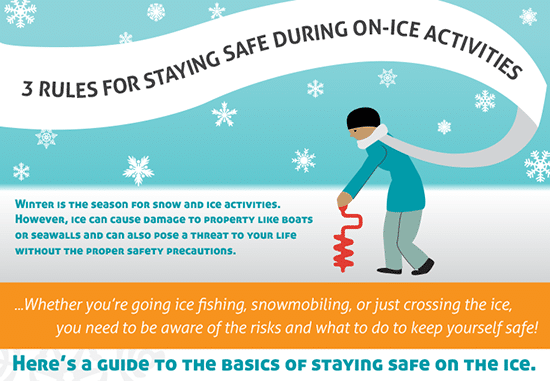Have Fun on the Ice—But Learn How to Stay Safe!

Whether you’re going ice fishing, snowmobiling, or just crossing the ice to get to the other side, you need to be aware of the risks and know what to do to keep yourself safe. Here’s a guide to the basics of staying safe on the ice.
Plan Ahead and Have What You Need
Before you go out on the ice, the first precaution you should take is to consult with a local source that’s knowledgeable about the ice conditions on that body of water. A fishing guide or bait shop is typically the one to go to, and is usually willing to answer your questions.
You should also be sure to let someone know your plan and the estimated time you plan to return. This way, if anything goes awry, people know where you are.
Finally, make sure to bring a set of ice picks or ice claws, as well as a way to measure the thickness of the ice.
Test the Ice Thickness
Before you head out on the ice, be sure that it is a type of ice that is safe to be on. Any ice that has snow on it can be considered unsafe as the snow insulates the ice below and keeps it from getting
cold enough to reach a safe thickness. Slush similarly indicates the ice is melting at the bottom. Seek bluish ice—milky ice formed from refrozen snow is half as strong as clear ice.
Test the thickness of the ice every few steps. This can be done in one of three ways, depending on the thickness of the ice. You can use an ice chisel, an ice auger (which can be hand-powered, electric, or gas), or a cordless drill with a long wood auger bit. Use one of these to make a hole, then use a tape measure to get a measurement.
Typically, you need 4 inches or more for walking or ice fishing, 5 for a snowmobile or ATV, and more for vehicles. A more complete breakdown of thicknesses required for different vehicle weights can be found here. Keep in mind that these values need to be adjusted for slush ice or river ice.
Know What to Do if You Fall Through
Despite your planning, ice can break unpredictably, especially in areas where there have recently been temperature fluctuations. If this happens, staying calm and knowing what to do can be the difference between life and death.
Don’t try to remove your winter clothing, as it can provide buoyancy with trapped air. Instead, turn toward the ice you came from, use your ice picks or claws to dig in, and vigorously kick your feet while pulling yourself onto the ice by sliding yourself forward. Once back on the ice, roll away from the breakage so as to evenly distribute your weight and avoid breaking through again.
Having made it out, you need to immediately make your way to a dry and warm place. If you have symptoms of hypothermia, you may need to call 911.
Ice in the winter can be a dangerous thing. This is true not just for you, but for property as well—ice floes can damage dams, boats, docks, and seawalls. If you’re a waterfront property owner and you’re concerned about the integrity of your seawalls, give Seawalls Unlimited a call at (815) 331-8830. We’ve been installing and servicing seawalls in McHenry, IL and the Chicago area for years. Our trained experts have extensive hands-on experience, and will take the best care of your seawalls.
With your seawalls protected, we hope you’ll go out on the ice and make the most of this holiday season—and stay safe while doing it!
Seawalls Unlimited
2350 W. Rte. 120
McHenry, IL 60051
(815) 331-8830

